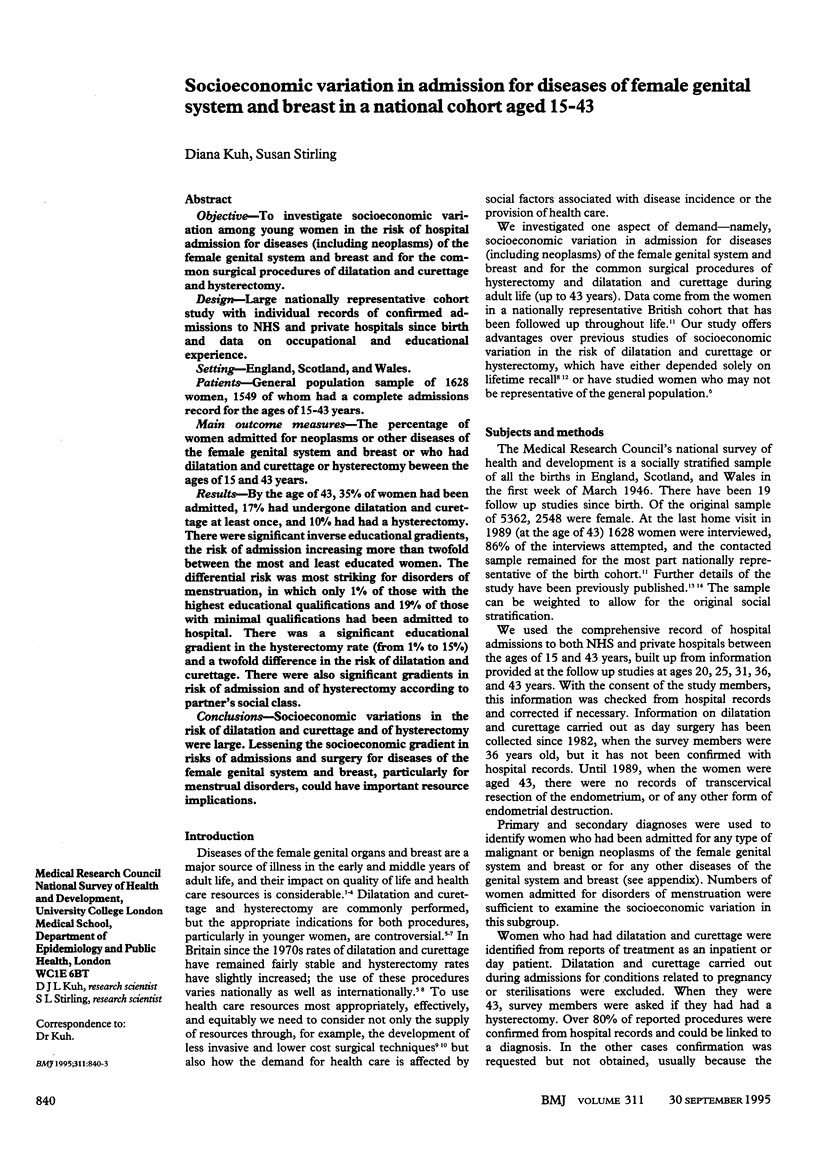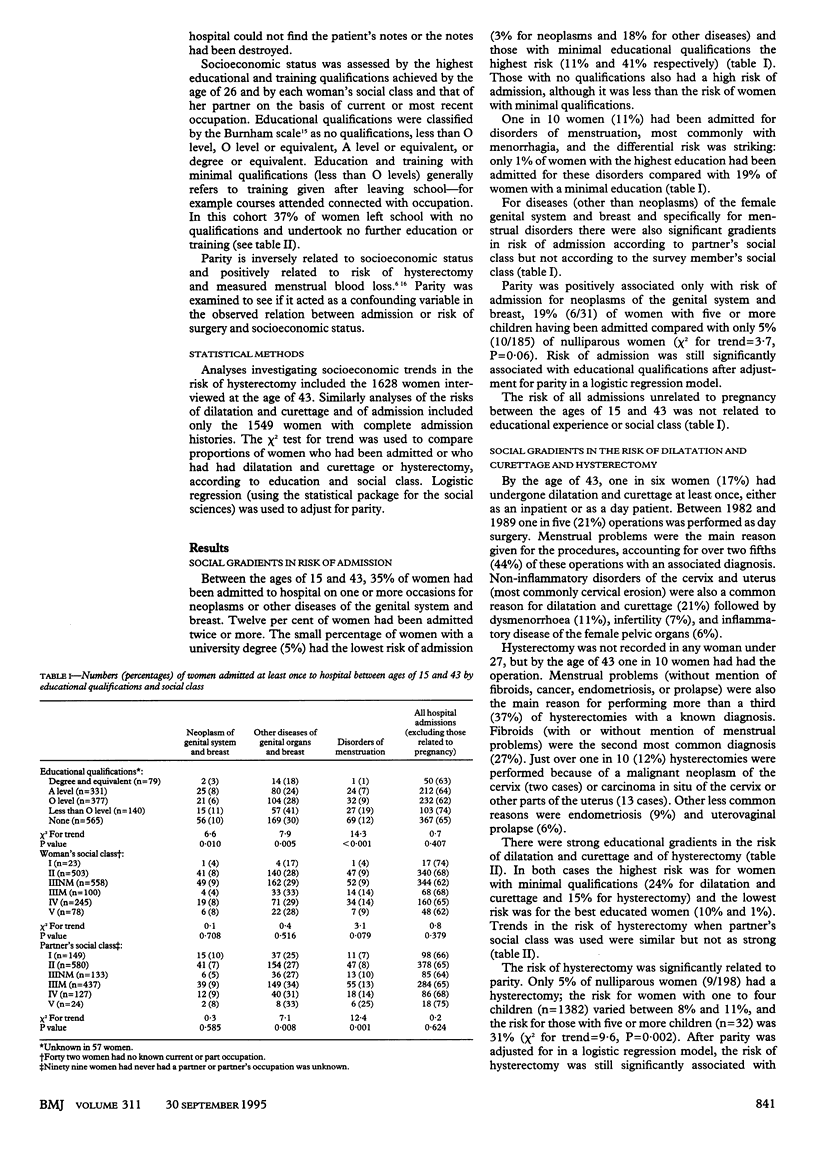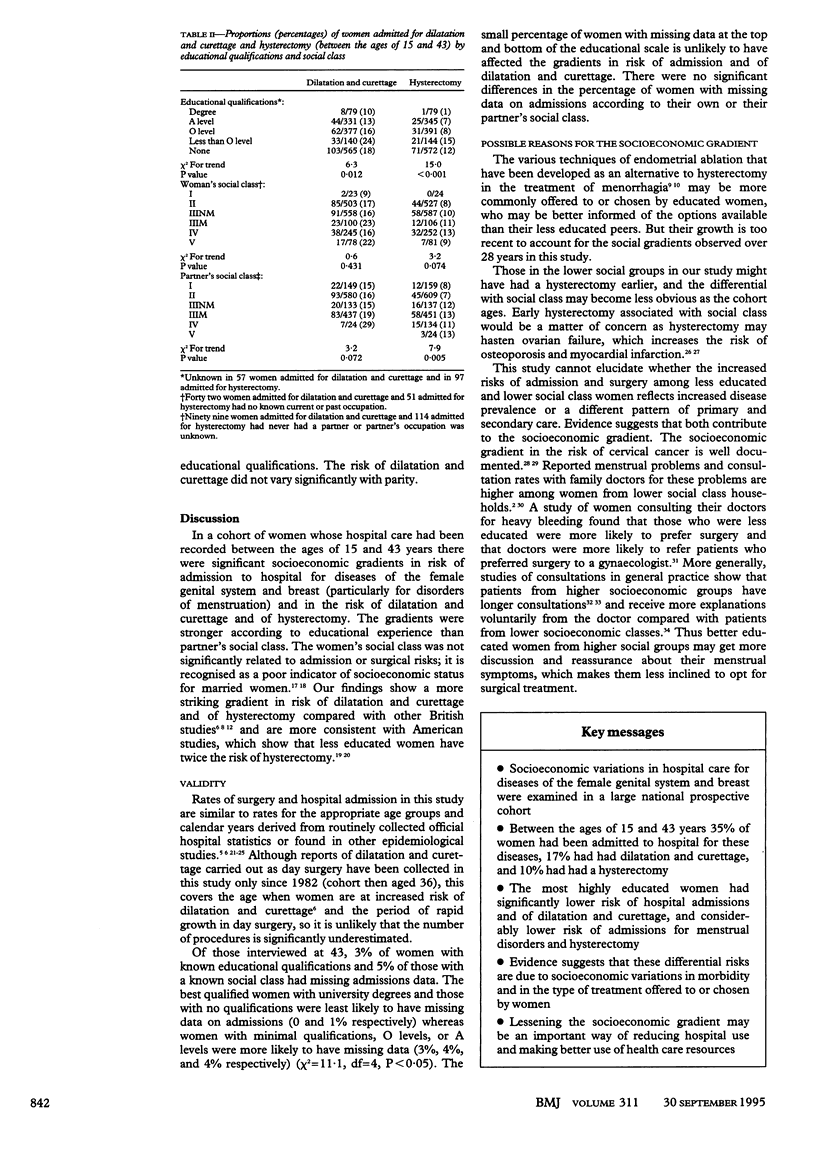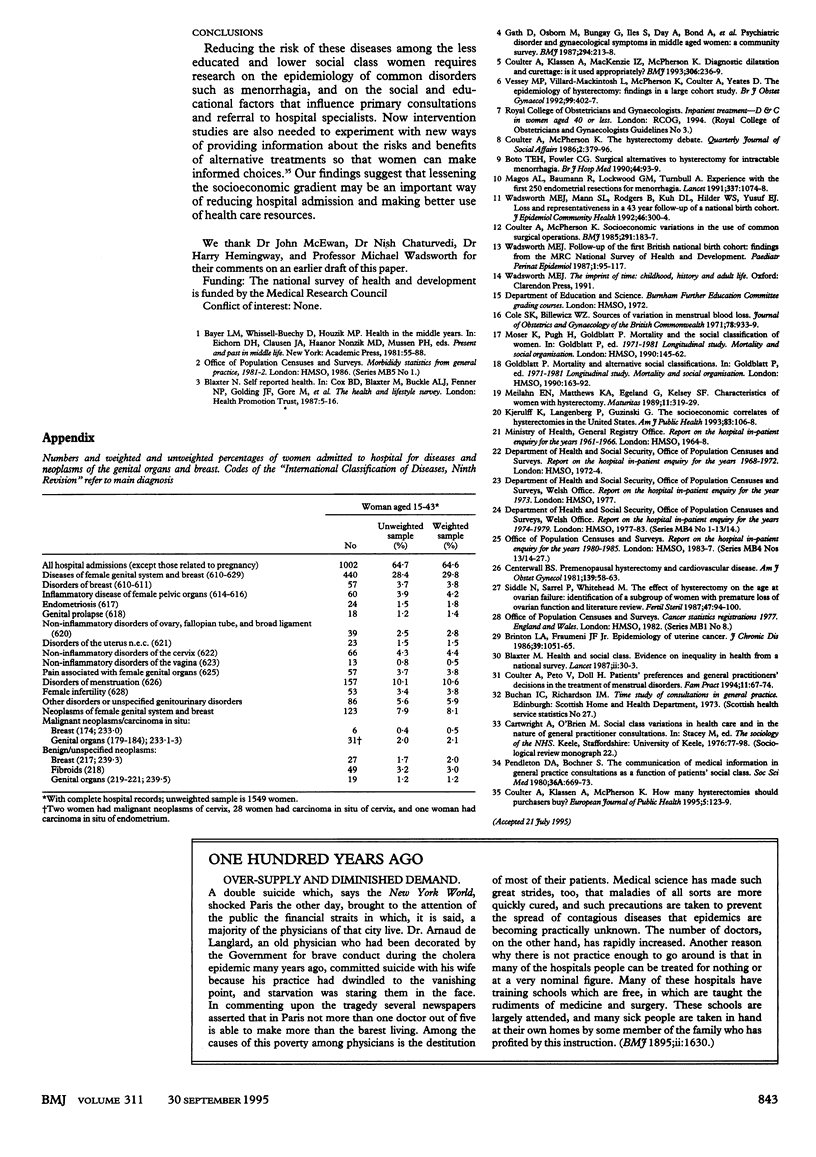Abstract
OBJECTIVE--To investigate socioeconomic variation among young women in the risk of hospital admission for diseases (including neoplasms) of the female genital system and breast and for the common surgical procedures of dilatation and curettage and hysterectomy. DESIGN--Large nationally representative cohort study with individual records of confirmed admissions to NHS and private hospitals since birth and data on occupational and educational experience. SETTING--England, Scotland, and Wales. PATIENTS--General population sample of 1628 women, 1549 of whom had a complete admissions record for the ages of 15-43 years. MAIN OUTCOME MEASURES--The percentage of women admitted for neoplasms or other diseases of the female genital system and breast or who had dilatation and curettage or hysterectomy between the ages of 15 and 43 years. RESULTS--By the age of 43, 35% of women had been admitted, 17% had undergone dilatation and curettage at least once, and 10% had had a hysterectomy. There were significant inverse educational gradients, the risk of admission increasing more than twofold between the most and least educated women. The differential risk was most striking for disorders of menstruation, in which only 1% of those with the highest educational qualifications and 19% of those with minimal qualifications had been admitted to hospital. There was a significant educational gradient in the hysterectomy rate (from 1% to 15%) and a twofold difference in the risk of dilatation and curettage. There were also significant gradients in risk of admission and of hysterectomy according to partner's social class. CONCLUSIONS--Socioeconomic variations in the risk of dilatation and curettage and of hysterectomy were large. Lessening the socioeconomic gradient in risks of admissions and surgery for diseases of the female genital system and breast, particularly for menstrual disorders, could have important resource implications.
Full text
PDF



Selected References
These references are in PubMed. This may not be the complete list of references from this article.
- Blaxter M. Evidence on inequality in health from a national survey. Lancet. 1987 Jul 4;2(8549):30–33. doi: 10.1016/s0140-6736(87)93062-5. [DOI] [PubMed] [Google Scholar]
- Boto T. C., Fowler C. G. Surgical alternatives to hysterectomy for intractable menorrhagia. Br J Hosp Med. 1990 Aug;44(2):93–99. [PubMed] [Google Scholar]
- Brinton L. A., Fraumeni J. F., Jr Epidemiology of uterine cervical cancer. J Chronic Dis. 1986;39(12):1051–1065. doi: 10.1016/0021-9681(86)90139-6. [DOI] [PubMed] [Google Scholar]
- Cartwright A., O'Brien M. Social class variations in health care and in the nature of general practitioner consultations. Sociol Rev Monogr. 1976 Mar;(22):77–98. doi: 10.1111/j.1467-954x.1974.tb00019.x. [DOI] [PubMed] [Google Scholar]
- Centerwall B. S. Premenopausal hysterectomy and cardiovascular disease. Am J Obstet Gynecol. 1981 Jan;139(1):58–61. doi: 10.1016/0002-9378(81)90412-9. [DOI] [PubMed] [Google Scholar]
- Coulter A., Klassen A., MacKenzie I. Z., McPherson K. Diagnostic dilatation and curettage: is it used appropriately? BMJ. 1993 Jan 23;306(6872):236–239. doi: 10.1136/bmj.306.6872.236. [DOI] [PMC free article] [PubMed] [Google Scholar]
- Coulter A., McPherson K. Socioeconomic variations in the use of common surgical operations. Br Med J (Clin Res Ed) 1985 Jul 20;291(6489):183–187. doi: 10.1136/bmj.291.6489.183. [DOI] [PMC free article] [PubMed] [Google Scholar]
- Coulter A., Peto V., Doll H. Patients' preferences and general practitioners' decisions in the treatment of menstrual disorders. Fam Pract. 1994 Mar;11(1):67–74. doi: 10.1093/fampra/11.1.67. [DOI] [PubMed] [Google Scholar]
- Gath D., Osborn M., Bungay G., Iles S., Day A., Bond A., Passingham C. Psychiatric disorder and gynaecological symptoms in middle aged women: a community survey. Br Med J (Clin Res Ed) 1987 Jan 24;294(6566):213–218. doi: 10.1136/bmj.294.6566.213. [DOI] [PMC free article] [PubMed] [Google Scholar]
- Kjerulff K., Langenberg P., Guzinski G. The socioeconomic correlates of hysterectomies in the United States. Am J Public Health. 1993 Jan;83(1):106–108. doi: 10.2105/ajph.83.1.106. [DOI] [PMC free article] [PubMed] [Google Scholar]
- Magos A. L., Baumann R., Lockwood G. M., Turnbull A. C. Experience with the first 250 endometrial resections for menorrhagia. Lancet. 1991 May 4;337(8749):1074–1078. doi: 10.1016/0140-6736(91)91718-a. [DOI] [PubMed] [Google Scholar]
- Meilahn E. N., Matthews K. A., Egeland G., Kelsey S. F. Characteristics of women with hysterectomy. Maturitas. 1989 Dec;11(4):319–329. doi: 10.1016/0378-5122(89)90028-5. [DOI] [PubMed] [Google Scholar]
- Pendleton D. A., Bochner S. The communication of medical information in general practice consultations as a function of patients' social class. Soc Sci Med Med Psychol Med Sociol. 1980 Dec;14A(6):669–673. doi: 10.1016/0160-7979(80)90072-7. [DOI] [PubMed] [Google Scholar]
- Siddle N., Sarrel P., Whitehead M. The effect of hysterectomy on the age at ovarian failure: identification of a subgroup of women with premature loss of ovarian function and literature review. Fertil Steril. 1987 Jan;47(1):94–100. doi: 10.1016/s0015-0282(16)49942-5. [DOI] [PubMed] [Google Scholar]
- Vessey M. P., Villard-Mackintosh L., McPherson K., Coulter A., Yeates D. The epidemiology of hysterectomy: findings in a large cohort study. Br J Obstet Gynaecol. 1992 May;99(5):402–407. doi: 10.1111/j.1471-0528.1992.tb13758.x. [DOI] [PubMed] [Google Scholar]
- Wadsworth M. E. Follow-up of the first national birth cohort: findings from the Medical Research Council National Survey of Health and Development. Paediatr Perinat Epidemiol. 1987 Apr;1(1):95–117. doi: 10.1111/j.1365-3016.1987.tb00093.x. [DOI] [PubMed] [Google Scholar]
- Wadsworth M. E., Mann S. L., Rodgers B., Kuh D. J., Hilder W. S., Yusuf E. J. Loss and representativeness in a 43 year follow up of a national birth cohort. J Epidemiol Community Health. 1992 Jun;46(3):300–304. doi: 10.1136/jech.46.3.300. [DOI] [PMC free article] [PubMed] [Google Scholar]


